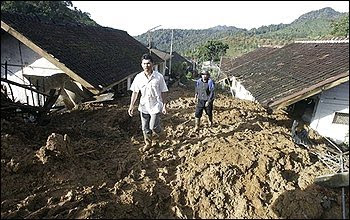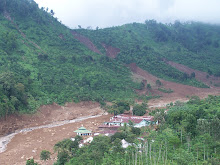
In recent years, an e-mail has been circulating which describes an alternative to the long-established "Drop, Cover, and Hold On" advice. The so-called "triangle of life" and some of the other actions recommended in the e-mail are potentially life threatening, and the credibility of the source of these recommendations has been broadly questioned (
http://earthquakecountry.info/dropcoverholdon/).
Earthquakes occur without any warning and may be so violent that you cannot run or crawl; you therefore will most likely be knocked to the ground where you happen to be. Given the dynamics of earthquakes and their effects on structures, "Drop, Cover, and Hold On" is the single most useful instruction that you can follow to protect yourself in the majority of situations. It gives you the best overall chance of protecting yourself during an earthquake... even during quakes that cause furniture to move about rooms, and even in buildings that might ultimately collapse.
Studies of injuries and deaths caused by earthquakes over the last several decades indicate that you are much more likely to be injured by falling or flying objects (TVs, lamps, glass, bookcases, etc.) than to die in a collapsed building. The "Drop, Cover, and Hold On" position will protect you from most of these injuries. If there is no nearby space beneath a table or other furniture that can provide protection from these objects, ONLY then you should get next to furniture such as a sofa that won't tip over, cover your head, and hold on to the furniture and be ready to move with it as it shifts in the shaking. If there is no furniture, get down next to an interior wall if possible (exterior walls are more likely to collapse and have windows that may break) and cover your head and neck with your arms. If you are in bed, the best thing to do is to stay where you are and cover your head with a pillow. Studies of injuries in earthquakes show that people who moved from their beds would not have been injured if they had remained in bed.
In many seismically active parts of the U.S. and other countries, strict building codes reduce the potential of structure collapse. However, there is the possibility of structural failure in certain building types, especially unreinforced masonry, and in certain structures constructed before the latest building codes. Rescue professionals are trained to understand how these structures collapse in order to identify potential locations of survivors. The ONLY exception to the "Drop, Cover and Hold On" rule is if you are in a country with un-engineered construction, and if you are on the ground floor of an unreinforced mud-brick (adobe) building, with a heavy ceiling. In that case, you should try to move quickly outside to an open space. This cannot be recommended as a substitute for building earthquake-resistant structures in the first place!
If you do become trapped in a collapsed building, it will be important to immediately protect your airway against dust and debris by breathing through clothing or material (preferably a dust mask if one has been stored near their desk, bed, or other accessible location); check yourself for injuries and control any bleeding; find a source of light if possible; and make your location known to rescuers by tapping on a solid object with a rock or other instrument. Save your breath and energy. Delay yelling for help until you hears rescuers very nearby.
If a building does collapse, rescue teams will methodically search through the rubble for victims, using tools, search dogs, and electronic instruments that can detect the presence of live people. Survivors are usually found in spaces large enough for a human within the collapse debris, called "Survivable Void Space." It can be as large as an adult, or in the case of small children or infants, a very small space. The main goal of "Drop, Cover, and Hold On" is to protect you from falling and flying debris and other nonstructural hazards, and to increase the chance of your ending up in a Survivable Void Space if the building actually collapses.
The "triangle of life" advice is based on several wrong assumptions:
• buildings always collapse and crush all furniture inside (wrong);
• residents can always anticipate how their building might collapse and anticipate the location of survivable void spaces (wrong); and
• during strong shaking people can move to a desired location (wrong).
Experts agree that in the rare case that a building collapses, residents inside will not be able to anticipate the location of void spaces nor move to them during the strong shaking before the collapse. Some other recommendations in the "triangle of life" email are also based on wrong assumptions and very hazardous. For example, the recommendation to get out of your car during an earthquake and lay down next to it assumes that there is always an elevated freeway above you that will fall and crush your car. Of course there are very few elevated freeways, and laying next to your car is very dangerous because the car can move and crush you. A compilation of rebuttals from many organizations to these alternative recommendations, as well as news articles about the controversy, is online at
www.earthquakecountry.info/dropcoverholdon.In conclusion, the "Drop, Cover and Hold On" protocol, when performed correctly with an awareness of your surroundings, remains the most effective single piece of advice that you can follow when an earthquake occurs. More detailed information about what to do during an earthquake can be found
here.
 Picture showing the village before landslide (left) and after landslide (right). (Indonesian Geology Agency)
Picture showing the village before landslide (left) and after landslide (right). (Indonesian Geology Agency) Villagers walk at a neighborhood hit by a landslide in Ciwidey district, West Java, Indonesia, Thursday, Feb. 25, 2010. Days of heavy rain prompted the landslide Tuesday afternoon at the mountainous tea plantation destroying scores of homes. (AP Photo/Irwin Fedriansyah)
Villagers walk at a neighborhood hit by a landslide in Ciwidey district, West Java, Indonesia, Thursday, Feb. 25, 2010. Days of heavy rain prompted the landslide Tuesday afternoon at the mountainous tea plantation destroying scores of homes. (AP Photo/Irwin Fedriansyah)



